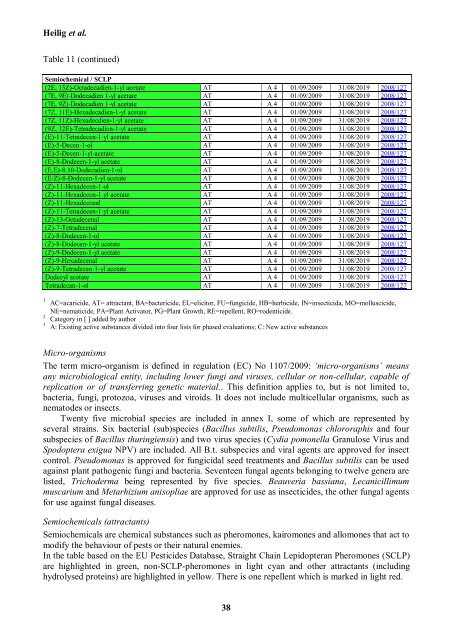Classical and augmentative biological control against ... - IOBC-WPRS
Classical and augmentative biological control against ... - IOBC-WPRS
Classical and augmentative biological control against ... - IOBC-WPRS
You also want an ePaper? Increase the reach of your titles
YUMPU automatically turns print PDFs into web optimized ePapers that Google loves.
Heilig et al.<br />
Table 11 (continued)<br />
Semiochemical / SCLP<br />
(2E, 13Z)-Octadecadien-1-yl acetate AT A 4 01/09/2009 31/08/2019 2008/127<br />
(7E, 9E)-Dodecadien 1-yl acetate AT A 4 01/09/2009 31/08/2019 2008/127<br />
(7E, 9Z)-Dodecadien 1-yl acetate AT A 4 01/09/2009 31/08/2019 2008/127<br />
(7Z, 11E)-Hexadecadien-1-yl acetate AT A 4 01/09/2009 31/08/2019 2008/127<br />
(7Z, 11Z)-Hexadecdien-1-yl acetate AT A 4 01/09/2009 31/08/2019 2008/127<br />
(9Z, 12E)-Tetradecadien-1-yl acetate AT A 4 01/09/2009 31/08/2019 2008/127<br />
(E)-11-Tetradecen-1-yl acetate AT A 4 01/09/2009 31/08/2019 2008/127<br />
(E)-5-Decen-1-ol AT A 4 01/09/2009 31/08/2019 2008/127<br />
(E)-5-Decen-1-yl-acetate AT A 4 01/09/2009 31/08/2019 2008/127<br />
(E)-8-Dodecen-1-yl acetate AT A 4 01/09/2009 31/08/2019 2008/127<br />
(E,E)-8,10-Dodecadien-1-ol AT A 4 01/09/2009 31/08/2019 2008/127<br />
(E/Z)-8-Dodecen-1-yl acetate AT A 4 01/09/2009 31/08/2019 2008/127<br />
(Z)-11-Hexadecen-1-ol AT A 4 01/09/2009 31/08/2019 2008/127<br />
(Z)-11-Hexadecen-1-yl acetate AT A 4 01/09/2009 31/08/2019 2008/127<br />
(Z)-11-Hexadecenal AT A 4 01/09/2009 31/08/2019 2008/127<br />
(Z)-11-Tetradecen-1-yl acetate AT A 4 01/09/2009 31/08/2019 2008/127<br />
(Z)-13-Octadecenal AT A 4 01/09/2009 31/08/2019 2008/127<br />
(Z)-7-Tetradecenal AT A 4 01/09/2009 31/08/2019 2008/127<br />
(Z)-8-Dodecen-1-ol AT A 4 01/09/2009 31/08/2019 2008/127<br />
(Z)-8-Dodecen-1-yl acetate AT A 4 01/09/2009 31/08/2019 2008/127<br />
(Z)-9-Dodecen-1-yl acetate AT A 4 01/09/2009 31/08/2019 2008/127<br />
(Z)-9-Hexadecenal AT A 4 01/09/2009 31/08/2019 2008/127<br />
(Z)-9-Tetradecen-1-yl acetate AT A 4 01/09/2009 31/08/2019 2008/127<br />
Dodecyl acetate AT A 4 01/09/2009 31/08/2019 2008/127<br />
Tetradecan-1-ol AT A 4 01/09/2009 31/08/2019 2008/127<br />
1 AC=acaricide, AT= attractant, BA=bactericide, EL=elicitor, FU=fungicide, HB=herbicide, IN=insecticida, MO=molluscicide,<br />
NE=nematicide, PA=Plant Activator, PG=Plant Growth, RE=repellent, RO=rodenticide.<br />
2<br />
Category in [ ] added by author<br />
3<br />
A: Existing active substances divided into four lists for phased evaluations; C: New active substances<br />
Micro-organisms<br />
The term micro-organism is defined in regulation (EC) No 1107/2009: ‘micro-organisms’ means<br />
any micro<strong>biological</strong> entity, including lower fungi <strong>and</strong> viruses, cellular or non-cellular, capable of<br />
replication or of transferring genetic material.. This definition applies to, but is not limited to,<br />
bacteria, fungi, protozoa, viruses <strong>and</strong> viroids. It does not include multicellular organisms, such as<br />
nematodes or insects.<br />
Twenty five microbial species are included in annex I, some of which are represented by<br />
several strains. Six bacterial (sub)species (Bacillus subtilis, Pseudomonas chlororaphis <strong>and</strong> four<br />
subspecies of Bacillus thuringiensis) <strong>and</strong> two virus species (Cydia pomonella Granulose Virus <strong>and</strong><br />
Spodoptera exigua NPV) are included. All B.t. subspecies <strong>and</strong> viral agents are approved for insect<br />
<strong>control</strong>. Pseudomonas is approved for fungicidal seed treatments <strong>and</strong> Bacillus subtilis can be used<br />
<strong>against</strong> plant pathogenic fungi <strong>and</strong> bacteria. Seventeen fungal agents belonging to twelve genera are<br />
listed, Trichoderma being represented by five species. Beauveria bassiana, Lecanicillimum<br />
muscarium <strong>and</strong> Metarhizium anisopliae are approved for use as insecticides, the other fungal agents<br />
for use <strong>against</strong> fungal diseases.<br />
Semiochemicals (attractants)<br />
Semiochemicals are chemical substances such as pheromones, kairomones <strong>and</strong> allomones that act to<br />
modify the behaviour of pests or their natural enemies.<br />
In the table based on the EU Pesticides Database, Straight Chain Lepidopteran Pheromones (SCLP)<br />
are highlighted in green, non-SCLP-pheromones in light cyan <strong>and</strong> other attractants (including<br />
hydrolysed proteins) are highlighted in yellow. There is one repellent which is marked in light red.<br />
38

















